Physical Address
304 North Cardinal St.
Dorchester Center, MA 02124
Regular exercise is an important part of a healthy lifestyle. Physical activity in some developed countries has diminished for a variety of reasons as society has trended away from outdoor activities toward other types of activities, such as computer games and television, and jobs have become more sedentary. Healthy levels of physical fitness require regular participation in activities that generate energy expenditures significantly above the resting level.
Exercise testing has become an integral part of the evaluation of children and adults with congenital and acquired cardiovascular disease. Although children are seldom sitting or lying quietly during waking hours, most of the testing available to the cardiovascular specialist is performed in such a resting state and sometimes in a sedated state. The evaluation of the patient in the exercise physiology laboratory allows the clinician to assess the cardiovascular system in a state that is more likely to reflect that of the normal daily physical activities.
Optimal exercise performance requires continuous coordinated interaction between multiple organ systems. The roles of the heart and lungs are to provide adequate energy substrates to working skeletal muscle and to remove the end products of aerobic and anaerobic metabolism during exercise. Most of the children whom we encounter in the exercise physiology laboratory have, or are suspected of having, cardiac anomalies. However, abnormalities of noncardiovascular origin may also play a role in limiting exercise performance even in patients with surgically repaired complex congenital cardiac defects. Any malfunctioning of the muscles, bones, blood, or nervous system will impair exercise performance. Therefore a modern laboratory for exercise physiology must be capable of assessing all exercise-related systems, including the cardiovascular, pulmonary, neurologic, hematologic, and musculoskeletal systems. Furthermore, accurate interpretation of exercise tests requires the proper equipment and personnel. This is particularly important as the cardiologist supervising the laboratory frequently evaluates children with real or suspected exercise limitations. These children seldom have any cardiovascular abnormalities but may have involvement of other organs, such as dysfunction of the pulmonary or musculoskeletal systems. Properly performed exercise testing and its interpretation should also be able to identify or exclude abnormalities of extracardiac organs that normally contribute to exercise performance.
This chapter briefly reviews basic exercise physiology as it relates to cardiopulmonary exercise testing. Discussed are the equipment required for performing an exercise test and its applications as well as assessment of the types of data obtained from exercise testing and their usefulness in the evaluation of the child with cardiovascular disease. Also reviewed are indications and contraindications for exercise testing in cardiovascular disease.
Assuring proper exercise performance requires the seamless and continuous meshing of multiple systems of organs. The classic illustration of Wasserman and colleagues ( Fig. 23.1 ) depicts the interaction of the key systems that couple internal cellular respiration to external pulmonary respiration during exercise. It shows the systems as a series of overlapping cogs, all of which must mesh seamlessly to allow exercise to occur. In such fashion, mechanical energy is produced from chemical energy at the cellular level, with subsequent delivery and removal of substrates for energy production and byproducts of muscle metabolism. All of this is accomplished while maintaining chemical and thermal homeostasis within narrow ranges.
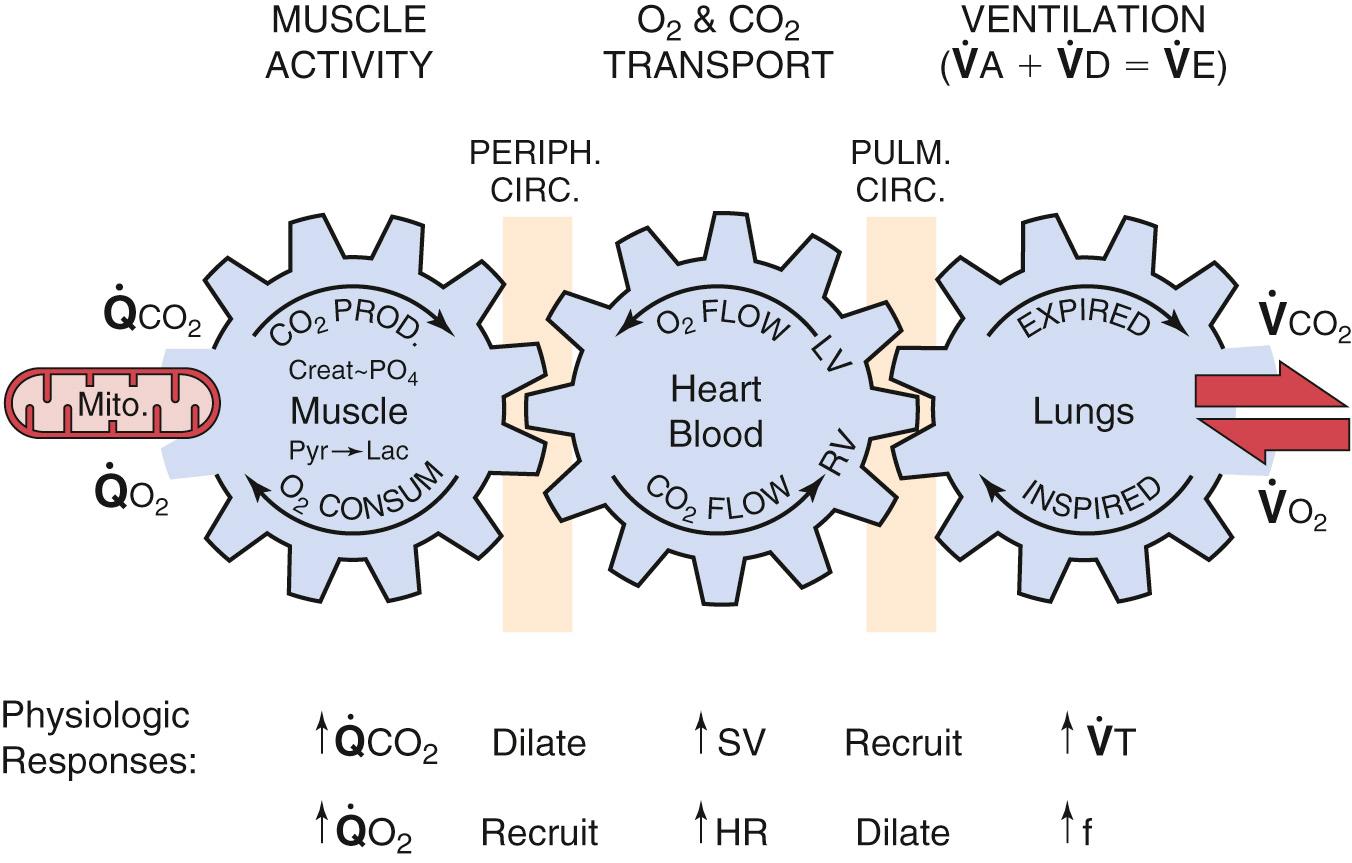
Adenosine triphosphate is the chief source of chemical energy for the exercising muscle. Mechanical energy is produced by the process of excitation-contraction coupling, driven by the breakdown of adenosine triphosphate and the release of inorganic phosphates and adenosine nucleotides. The stores of adenosine triphosphate and phosphocreatine in the myocytes are sufficient only for 10 to 15 seconds of activity and so must continuously be replenished. As can be seen in Fig. 23.2 , adenosine triphosphate is produced in small amounts in the cytosol by anaerobic metabolism. Much larger amounts are produced aerobically in the mitochondria.
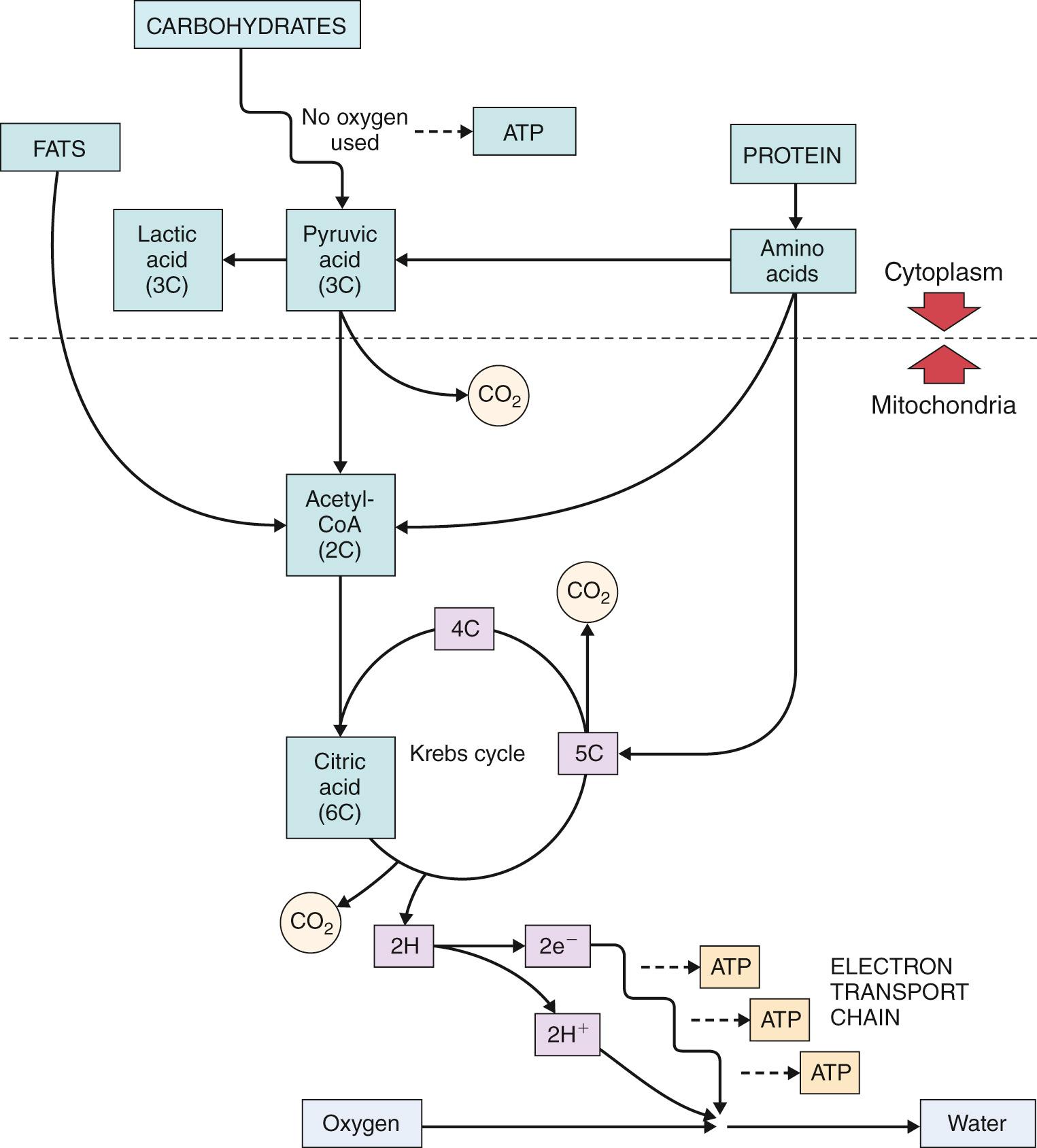
Anaerobic and aerobic metabolic activities use glucose, which is metabolized to pyruvate. Pyruvate then has two possible fates. It may be converted into lactic acid and excreted into the bloodstream, where it is buffered by sodium bicarbonate converting it to lactate. This reaction results in the production of carbon dioxide and water, along with small amounts of adenosine triphosphate, and the former are excreted in the lungs. The lactate molecule is taken up by the liver for resynthesis to glucose and glycogen, which can then be used again for energy production.
The other fate of pyruvate is aerobic metabolism. Pyruvate is converted into acetyl-coenzyme A and transported into the mitochondria, where it enters the Krebs cycle, again producing carbon dioxide and water. Adenosine triphosphate is produced in large quantities via the electron transport chain, with oxygen functioning as the terminal electron acceptor. Unlike anaerobic metabolism, fats and carbohydrates can undergo aerobic metabolism. Fats enter aerobic metabolism at the level of the Krebs cycle and do not undergo anaerobic metabolism.
During any activity, the availability and use of substrates, primarily fats or carbohydrates, will vary depending upon the type, intensity, and duration of activity. Fats are more reduced than carbohydrates, requiring more oxygen for complete oxidation compared with carbohydrates on a mole-for-mole basis. The ratio of production of carbon dioxide to consumption of oxygen, abbreviated to V CO /V O , is called the ratio of respiratory exchange or, if in a steady state, the respiratory quotient. In a state of high use of fat, the ratio is approximately 0.7. Conversely, during pure carbohydrate metabolism, the ratio is 1.0, reflecting the lower amount of oxygen needed to oxidize carbohydrates. The stores of glycogen in the adult body are seldom more than approximately 1500 Kcal. Therefore some use of fat is almost always required. As a result, the resting ratio of respiratory exchange, even in the well-fed state, will usually range from 0.85 to 0.9.
During a typical graded maximal exercise test, the work rate is gradually increased over the course of approximately 10 to 15 minutes, as explained in our subsequent sections concerning exercise protocols. Production of adenosine triphosphate will need to increase as mechanical work increases, and at low levels of work this increase is met predominately by increased aerobic metabolism. As work rate increases, consumption of oxygen increases in a linear fashion ( Fig. 23.3 ). Near peak work rates, oxygen consumption will tend to plateau, as maximal consumption is achieved. This phenomenon is often absent in children.
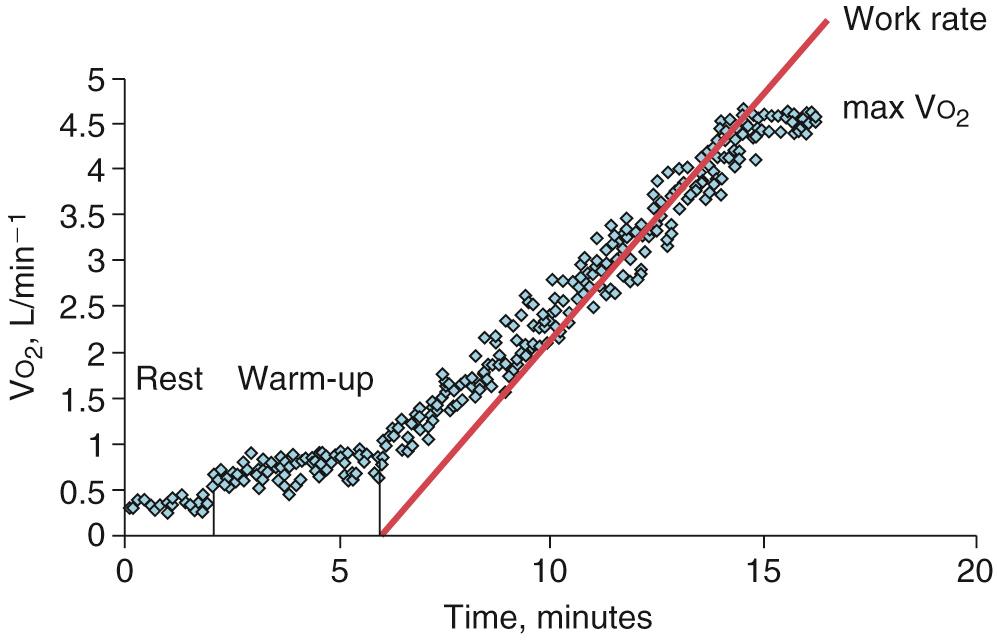
As consumption of oxygen increases in response to increased work rate, there is a gradual rise in the ratio of respiratory exchange. The reason for this rise is twofold. First, there is a gradual shift in use of carbohydrates compared with fats. This shift allows for more efficient use of oxygen because the yield of adenosine triphosphate per liter of oxygen is greater with carbohydrates compared with fats. Secondly, the rise in the ratio occurs as a result of increased levels of lactic acid in the blood. At approximately 50% to 60% of the maximal consumption of oxygen, levels of lactic acid begin to rise in the serum. This point is known as the lactate threshold. The onset of anaerobic metabolism by the exercising muscles is responsible for this production of lactic acid. The etiology of the lactate threshold appears to be the limited delivery of oxygen to the exercising muscles. The oxygen tension in the exercising muscle capillary bed must remain at a level that will allow the diffusion of dissolved oxygen to the exercising muscle's mitochondria. At sea level, barometric pressure and a normal arterial hemoglobin content, approximately 6 L of blood must be delivered to the exercising muscles for each liter of oxygen used in aerobic metabolism, to maintain this critical capillary oxygen tension throughout the course of the capillary bed.
Above the threshold, levels of lactic acid rise exponentially as work rate increases, necessitating increased buffering by sodium bicarbonate to maintain blood pH homeostasis. The by-product of the buffering process, carbon dioxide, must be removed to maintain arterial carbon dioxide levels within the normal range. This causes a significant rise in production of carbon dioxide out of proportion to the rise in consumption of oxygen, resulting in the respiratory exchange ratio increasing to greater than 1.0. The ratio in adults at peak exercise may be as high as 1.2 to 1.4 but is often lower in children.
The increase in production of carbon dioxide associated with the buffering of lactic acid allows for measurement of a noninvasive surrogate of the lactate threshold. This surrogate, known as the ventilatory anaerobic threshold, is defined as the point where production of carbon dioxide, and minute ventilation, begin to rise out of proportion to the consumption of oxygen. Like the lactate threshold, the ventilatory anaerobic threshold occurs at approximately 50% to 60% of the maximal consumption of oxygen. It may be significantly lower or higher in deconditioned or highly trained athletes, respectively. Like maximal consumption of oxygen, the ventilatory anaerobic threshold is a physiologic limit and has been used as a marker of aerobic fitness. Unlike maximal consumption of oxygen, the ventilatory anaerobic threshold has the virtue of being effort independent, is a level of exercise that can be sustained over a prolonged period of time, and is easily affected by training or sedentary behavior. Unfortunately, the ventilatory anaerobic threshold can be especially difficult to measure accurately in smaller children, who tend to have erratic patterns of breathing.
As previously mentioned, consumption of oxygen rises in near linear response to increasing work rate. The consumption can be derived from the Fick equation as follows:
Where V O is consumption, Q is cardiac output, and a − v O 2 diff is the difference in content of oxygen is arterial and mixed venous blood. Q is defined as:
where SV is stroke volume and HR is heart rate. Rearranging the equations, V O can be calculated as:
Therefore the rise in consumption of oxygen during exercise is dependent on the increases in stroke volume and heart rate, and widening of the difference in the content of oxygen in arterial and mixed venous blood. During strenuous exercise, cardiac output may rise as much as fivefold over resting levels. Both stroke volume and heart rate contribute to this increase, but the relative contributions of each are different. At rest, stroke volume is approximately 60% of its maximal value. At the onset of exercise, a combination of increased venous return and sympathetic tone causes stroke volume to increase. This occurs as consequence of two mechanisms. First, increased preload stretches the myocyte and increases tension, resulting in changes in the Frank-Starling forces. Second, the increase in sympathetic tone results in an increase in the inotropic state of the myocardium. This increase in inotropy improves the active tension developed for any given preload, thus further augmenting stroke volume. Most of the increase in stroke volume takes place at less than 30% to 40% of the maximal consumption of oxygen ( Fig. 23.4 ). At higher heart rates, diastolic filling time is decreased, which limits any further augmentation in stroke volume irrespective of any increase in the inotropic state. Therefore, at higher heart rates and naturally at higher workloads, the relative contribution of stroke volume to the overall increase in cardiac output is small.
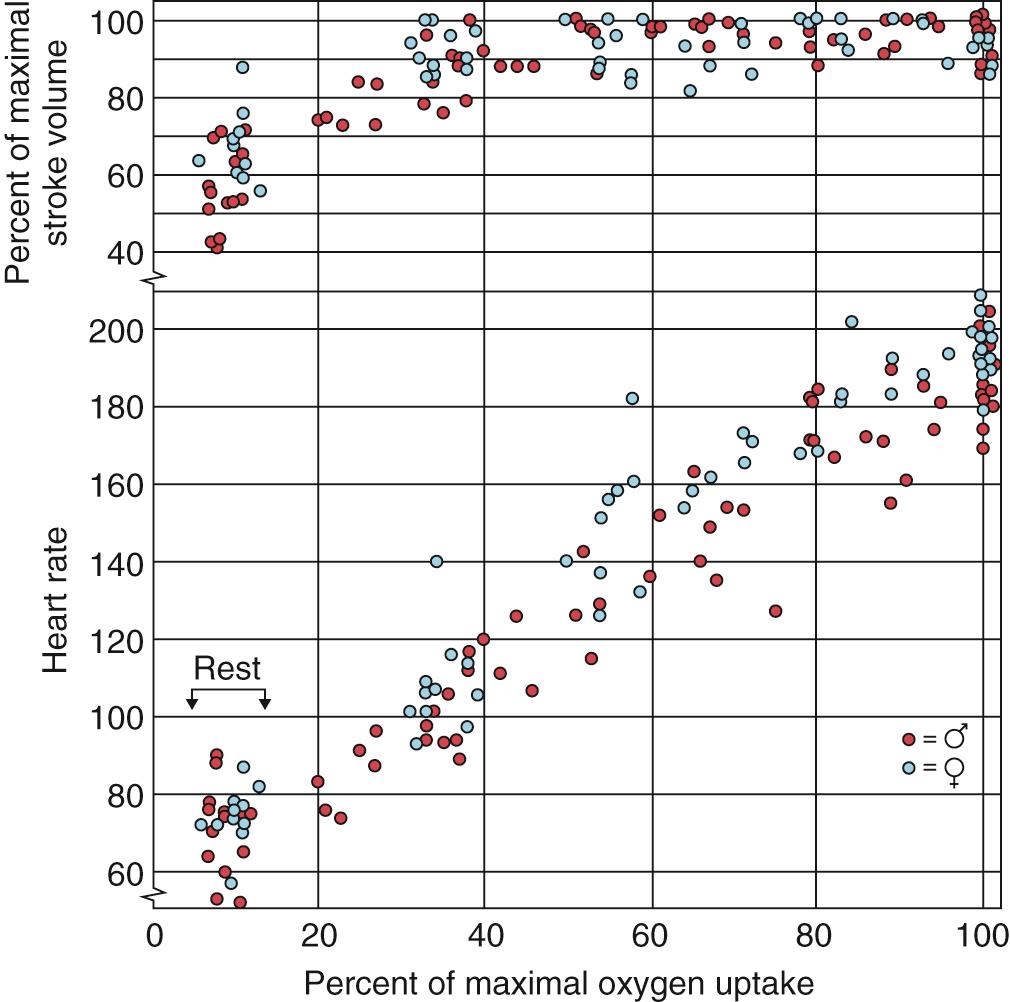
It should be noted that cardiac output response to exercise varies quite strikingly with position. The pattern described earlier applies to upright exercise. There is even less stroke volume augmentation when exercise is performed in the supine position because preload has already been redistributed from the lower extremities to central circulation at rest without further effect due to the muscle pump. Stroke volume and cardiac output at both rest and peak exercise are higher during supine exercise, whereas heart rate is higher during upright exercise. This can have implications when trying to interpret studies performed semisupine or supine (e.g., used in some labs to facilitate for stress echocardiography). This can be an important consideration in diagnoses where venous pooling, autonomic function, or limited stroke volume augmentation are particularly relevant, such as postural orthostatic tachycardia syndrome or in the Fontan circulation.
An increase in heart rate is the primary mechanism for the increased cardiac output at higher work rates. This is reflected in the essentially linear relationship between heart rate and consumption of oxygen as work rates increase (see Fig. 23.4 ). Therefore the ability to increase heart rate normally during exercise is essential to achieving a normal aerobic capacity. The difference in content of oxygen between the arterial and mixed venous blood gradually widens with increasing work rate and consumption of oxygen, as a result of increased extraction of oxygen by the exercising muscles. The by-products of myocytic metabolism, including hydrogen, carbon dioxide, and lactate, all lower the pH, thereby shifting the oxygen-hemoglobin dissociation curve down and rightward, favoring increased unloading of oxygen at the level of the exercising muscle. Such unloading is more pronounced at higher intensities of exercise, when the concentration of metabolic by-products is greater. This will be discussed in more detail later, in the relationship between consumption of oxygen and cardiac output.
For consumption of oxygen to increase during exercise, it is essential that cardiac output not only increase but that blood flow is preferentially shunted to the exercising muscles ( Fig. 23.5 ). At peak exercise, blood flow to exercising muscle may be 80% or more of the total cardiac output. The redistribution of blood flow is achieved by a combination of autonomic and metabolic vasoregulatory mechanisms. Exercise is essentially a state of increased sympathetic nervous system tone, which is regionally overridden by metabolic vasodilation. The increase in sympathetic tone associated with exercise results in a generalized constriction of the precapillary resistance arterioles. Simultaneously, the sympathetic tone increases heart rate and cardiac contractility, resulting in increased cardiac output. Vasodilation occurs at the level of the exercising muscle as a result of local metabolic changes. Aerobic and anaerobic metabolism, excitation-contraction coupling, and breakdown of adenosine triphosphate all result in the release of potent vasodilators into the interstitial spaces. These vasodilators include free potassium and hydrogen ions, carbon dioxide, lactate, adenosine diphosphate, and inorganic phosphate. The result is a profound vasodilation of the vascular bed in the exercising muscles.
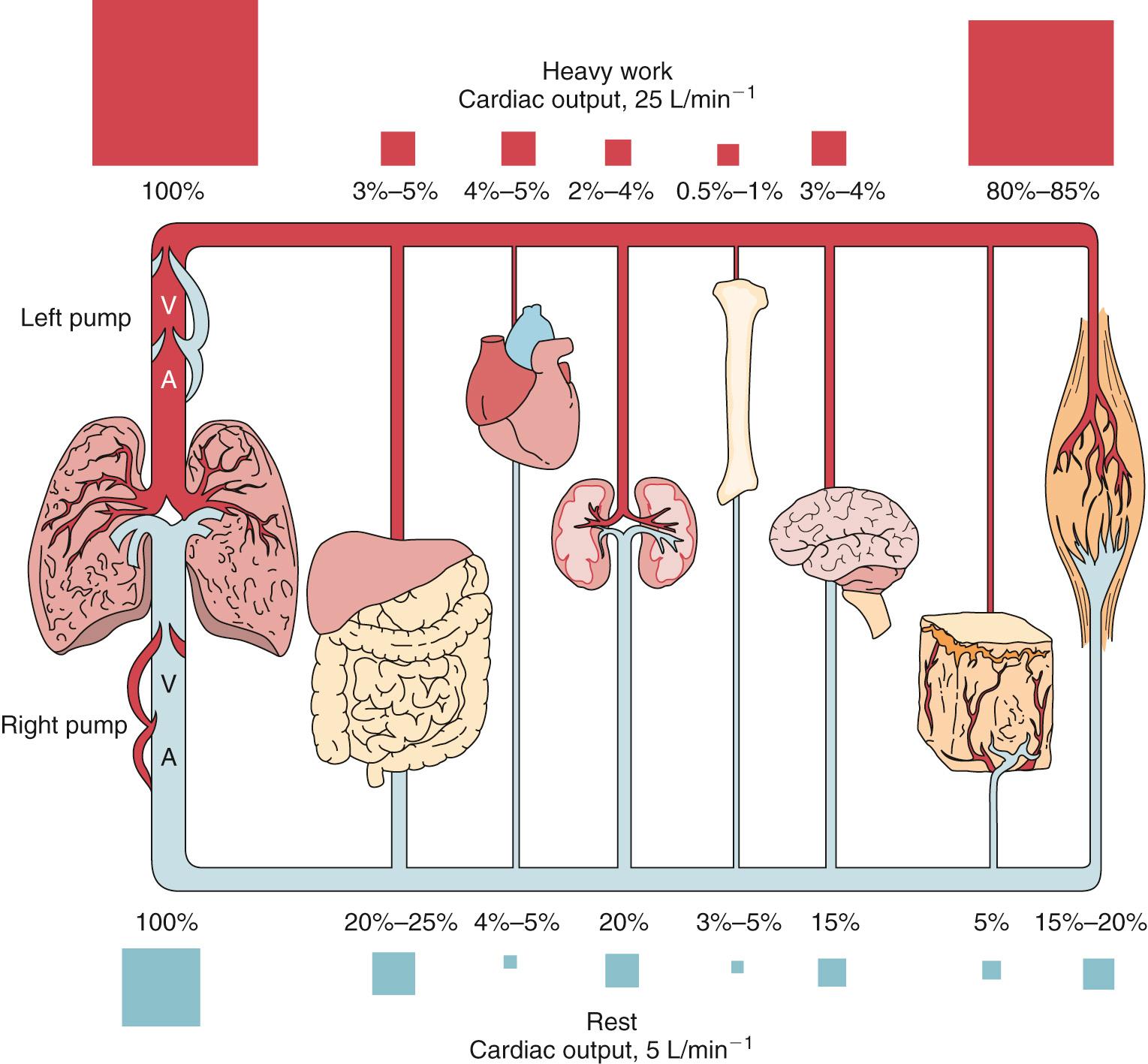
Vasoconstriction of the splanchnic vascular bed results in either no change or a decrease in flow of blood to the gut and kidneys. The effect on the overall peripheral vascular resistance depends on the size of the exercising muscle groups. During dynamic exercise, such as running, which uses large muscle groups, the net result is a significant drop in systemic vascular resistance, despite an overall increase in sympathetic tone.
Exercise testing is frequently performed to assess the ability of the cardiovascular system to increase cardiac output in response to an increased workload. However, measurement of cardiac output during exercise is often not practical. Direct measurements are too invasive to allow adequate levels of exertion. Noninvasive methods are often technically difficult and may be inaccurate in the pathophysiologic states that are encountered in many types of congenitally malformed hearts. The presence of obstacles to accurately and reliably measure cardiac output have led to the use of consumption of oxygen as a surrogate of cardiac output in many clinical and research settings. Over a broad range of consumption of oxygen, there is a nearly linear relationship between consumption of oxygen and cardiac output ( Fig. 23.6 ).
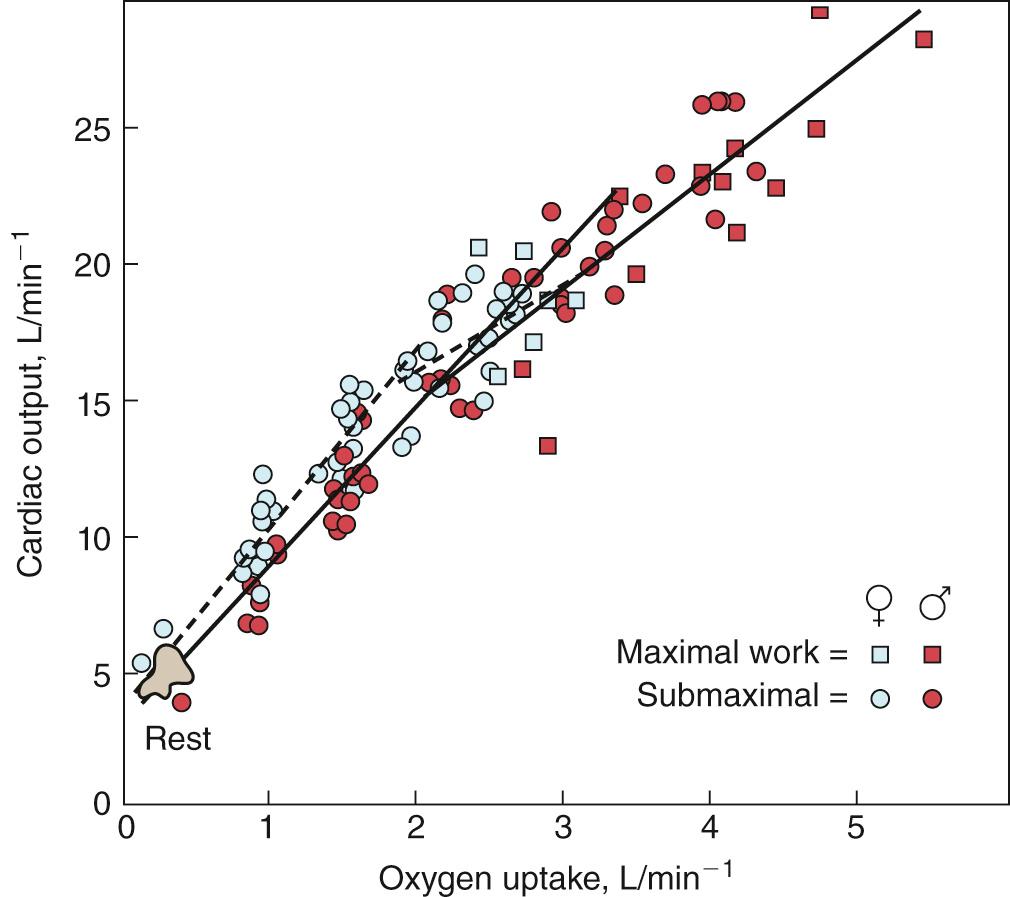
Even after a plateau in cardiac output at higher workloads, consumption of oxygen continues to increase as a result of increased oxygen extraction, thereby increasing the arterial–mixed venous content of oxygen difference. Consumption of oxygen is determined by the amount of oxygen delivered in the blood that is extracted by the metabolically active tissues. During exercise, this extraction is determined by the myoglobin content of the exercising muscle, the isoenzyme characteristics of the muscle, and the physiologic milieu in which the muscle is working. The physiologic state will have a great impact on the oxygen-hemoglobin dissociation curve. As previously stated, there are multiple by-products of muscle metabolism that are released into the intercellular space during exercise, shifting the oxygen-hemoglobin dissociation curve down and to the right. The local increase in muscle temperature during exercise also has the same effect. The net result is an increase in oxygen unloading to the exercising muscle particularly at high workloads. There is therefore an increase in the arterial–mixed venous content of oxygen difference and a continued rise in consumption of oxygen, even in the presence of a flattening or plateauing of the rise in cardiac output near peak exercise.
Gender differences are present in the relationship between cardiac output and consumption of oxygen (see Fig. 23.6 ). Females tend to have a somewhat higher cardiac output for any given oxygen consumption, as well as a lower maximal consumption. These differences are likely due to the difference in hemoglobin concentration between males and females. Females have lower levels of hemoglobin compared with males and therefore have lower arterial oxygen content, necessitating a higher cardiac output to deliver an equivalent quantity of oxygen. Lower values in adolescent and adult females manifest clinically in slightly higher cardiac outputs and lower consumption of oxygen at peak exercise. It is easy to comprehend how anemia will result in reduced consumption of oxygen and a higher ratio of cardiac output to consumption of oxygen compared with nonanemic states. Therefore the use of consumption of oxygen as a surrogate for cardiac output is problematic in the presence of anemia. Mitochondrial diseases that impair muscle oxygen utilization and hemoglobinopathies that alter oxygen affinity can have an equivalent effect but are much less common than anemia.
In a clinical setting the practitioner is frequently interested in assessing the intrinsic inotropic state of the myocardium during exercise. As was stated earlier, this state is primarily reflected by the stroke volume of the heart. A noninvasive measurement of stroke volume is a useful tool to assess myocardial function. This has given rise to the use of oxygen pulse during exercise testing.
The oxygen pulse is defined as:
Because:
The pulse also equals:
The oxygen pulse can be measured at any given work rate or consumption of oxygen during exercise testing. As long as the A-V oxygen difference remains stable, a rise or fall in stroke volume will correlate with a rise or fall in the oxygen pulse. These changes can be blunted somewhat by an increase or decrease in the difference in content of oxygen between arterial and mixed venous blood, but the ability of muscles to extract oxygen usually does not significantly change except in response to prolonged training. This is particularly true at maximal exercise. The oxygen pulse is perhaps most useful in assessing changes in myocardial performance over time, or following therapeutic interventions in an individual patient. Assuming no change in the hemoglobin content or arterial oxygen saturation, the content of oxygen of the arterial blood should be unchanged. Absent large weight changes, the consumption of oxygen required to perform a given amount of work on an ergometer for an individual patient is constant. Therefore any increase in the oxygen pulse measured at a given work rate would reflect a lower heart rate needed to achieve the same consumption of oxygen and be indicative of a higher stroke volume. The converse would be true for a falling oxygen pulse. This does presume the hemoglobin content of the blood has not changed and that the chronotropic state of the heart is also unchanged. A significant change in either of these limits the usefulness of the oxygen pulse to act as a marker of stroke volume during exercise.
Consumption of oxygen and removal of carbon dioxide require that the cardiovascular and pulmonary systems work together as an integrated unit. The ultimate goal is that for a given consumption of oxygen, the carbon dioxide produced is eliminated while maintaining PaCO 2 and pH within a narrow physiologic range. For this reason, it is not surprising that there is a close relationship between minute ventilation, oxygen consumption, and carbon dioxide production. This relationship is expressed in the ventilatory equivalents for carbon dioxide and oxygen, represented as VE/V CO 2 and VE/V O 2 . The typical relationship of minute ventilation to increasing work rate and the relationship of the ventilatory equivalents for carbon dioxide and oxygen to work rate are depicted in Fig. 23.7A . Note the steady rise in minute ventilation with increasing work rate. Both ventilatory equivalents initially fall at the onset of exercise and then plateau. During the plateau phase, minute ventilation is increasing in proportion to both the increases in the production of carbon dioxide and consumption of oxygen. At the onset of the ventilatory anaerobic threshold, minute ventilation begins to increase out of proportion to consumption of oxygen as the respiratory drive is more prominently stimulated by increased production of carbon dioxide occurring as a consequence of the buffering of lactic acid to maintain PaCO 2 . Note in Fig. 23.7B that, at this point, the ventilatory equivalent for oxygen begins to rise while the ventilatory equivalent for carbon dioxide remains stable. At maximal exercise, production of lactic acid may rise to a level that can no longer be adequately buffered by sodium bicarbonate and frank metabolic acidosis ensues. The normal physiologic response to acidosis is a marked hyperventilatory response referred to as terminal hyperventilation (respiratory compensation). At terminal hyperventilation, both the ventilatory equivalents for oxygen and carbon dioxide rise, resulting in a significant fall in PaCO 2 .
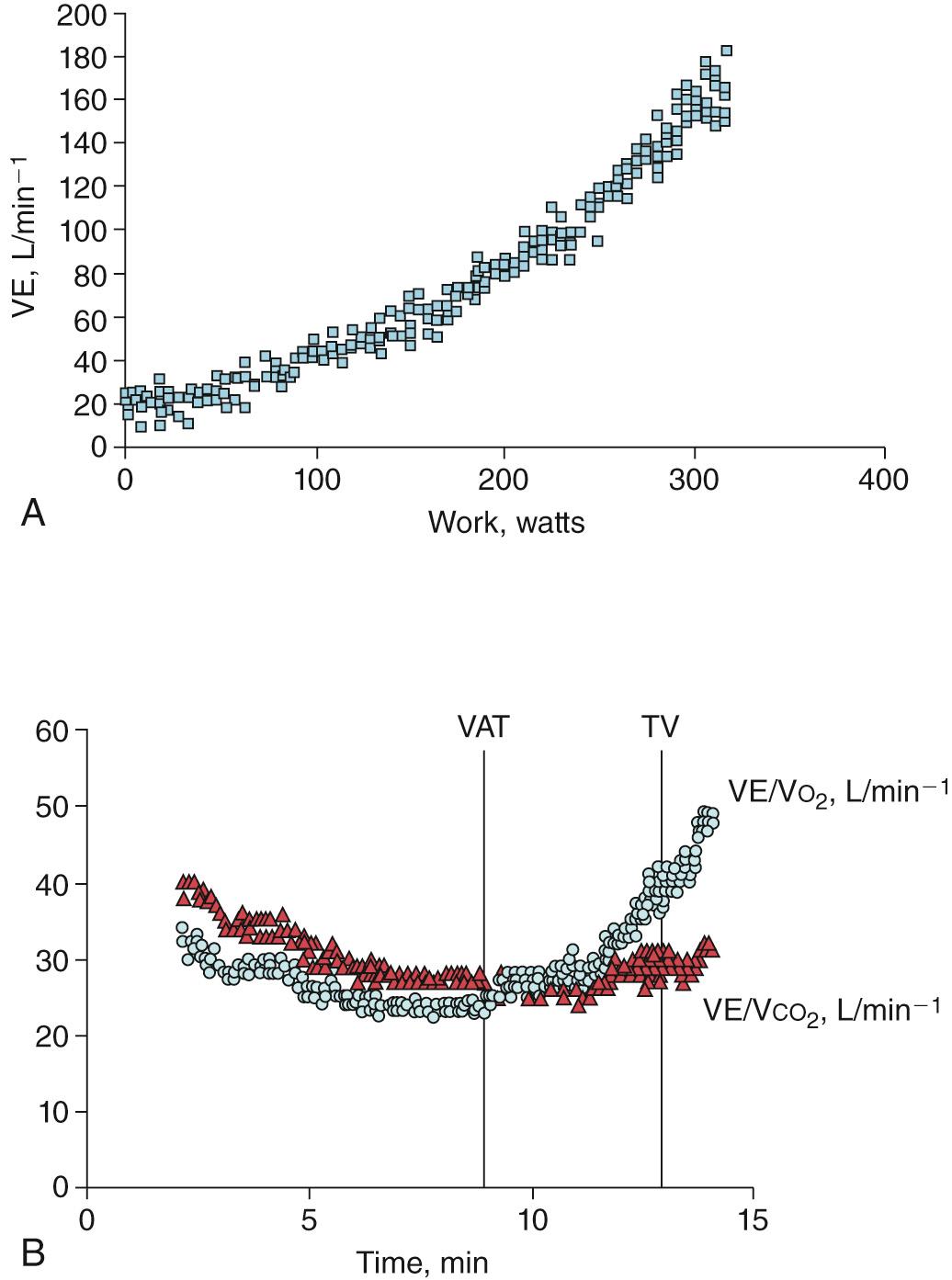
Minute ventilation is defined as:
where VT is tidal volume and F is respiratory rate. At the onset of exercise, minute ventilation initially increases primarily by an increase in tidal volume rather than respiratory rate. Tidal volume includes both alveolar ventilation and the physiologic dead space. Physiologic dead space is made up of both anatomic components, the trachea and bronchi, and the functional dead space, namely the ventilation of hypoperfused or nonperfused pulmonary components. At rest the ratio of dead space to tidal volume is approximately 30% to 35% in adults and adolescents. With the increase in tidal volume at the onset of exercise, the ratio falls. This is due to a larger tidal volume relative to the fixed anatomic dead space. In addition, there is an improvement in ventilation-to-perfusion matching as the increased negative thoracic pressure causes recruitment of additional capillary beds, resulting in a fall in the physiologic dead space. At peak exercise, the ratio of dead space to tidal volume may fall to approximately 5% to 15%. Children typically have less efficient ventilation than either adolescents or adults and tend to have a higher respiratory rate for any given minute ventilation, resulting in a higher ratio at any level of exercise.
At higher levels of exercise, minute ventilation increases due to increases in both tidal volume and respiratory rate. Much of the improvement in the ratio occurs at lower to moderate levels of work. The rapid fall in the ratio is responsible for the initial steep fall in the ventilatory equivalents for oxygen and carbon dioxide that occurs at the onset of exercise (see Fig. 23.7B ). Although both consumption of oxygen and production of carbon dioxide are increasing in early exercise, this is more than compensated for by the improved efficiency of the lungs, resulting in a less than proportional rise in minute ventilation.
In healthy children and adults, ventilation is not the rate-limiting step in exercise performance. This is because the cardiovascular system usually reaches its limit of delivery of oxygen before the pulmonary system is exhausted. At the maximal level of exercise, most subjects have not maximally stressed their pulmonary system, and there is pulmonary reserve, which is described by exercise physiologists as the breathing reserve. This is the theoretical ability to increase minute ventilation that remains untapped at maximal minute consumption of oxygen. This value is in the range of 20% to 50% in healthy children and adults.
Breathing reserve is defined as:
and is expressed as a percentage, where VE is the maximally achieved VE at peak exercise and MVV is maximal voluntary ventilation. Maximal voluntary ventilation is obtained by having the subject hyperventilate for 10 seconds as vigorously as possible prior to exercise testing. Much longer periods of rapid and deep breathing may result in fainting and should be avoided. The volume achieved is then multiplied by 6, theoretically to give a maximally achievable minute ventilation. A low breathing reserve, of less than 20%, may indicate that a primary pulmonary abnormality is limiting exercise performance. Because maximal voluntary ventilation is a highly effort-dependent measurement, care must be taken when interpreting breathing reserve. Other confirmatory data, such as an abnormal response of the ventilatory equivalents or abnormal resting spirometry, should be sought to confirm pulmonary abnormalities.
Adequate space and environmental controls are important to ensure a successful exercise test. The child should be made to feel comfortable and relaxed, which will improve exercise performance. Sufficient space is needed to accommodate the various ergometers and monitoring equipment, including emergency resuscitation equipment, while maintaining adequate space to access the patient in emergency situations. A minimum of 250 square feet of space is required, with 500 square feet or more when multiple work stations are used.
The climate of the laboratory must be well controlled to allow proper thermoregulation during the exercise test. The room should be well ventilated, and temperatures should be regulated between 20°C and 23°C, a temperature range that permits the patient to be comfortable at rest but still allows for adequate dissipation of heat during exercise. Humidity should be approximately 50% to ensure free perspiration during exercise.
Exercise laboratory conditions may be intentionally altered to simulate the environment in which the patient or referred athlete has been experiencing symptoms. The laboratory should be child friendly. For example, wall posters and television monitors with appropriate programing have proven useful in minimizing patient anxiety and boredom.
Exercise testing has been performed in children with very low risk, even in those who have complex cardiovascular disease. Although significant complications of exercise testing are rare, proper safety precautions are essential. Key staff usually include at least one physician who is well trained in pediatric exercise testing. A physician does not need to be directly present for testing patients deemed to be at relatively low risk but should be present at the testing of any child deemed to be at increased risk of a complication, such as a child with a history of life-threatening arrhythmia or syncope. The American Heart Association has published guidelines for patients who are at low risk for exercise complications and require a physician available but not physically present ( Box 23.1 ). The risk for each patient must be individually assessed. Ideally, two staff members trained in exercise testing should be present for all tests. All exercise physiologists or exercise technicians should be familiar with pediatric exercise testing, and at least one of these personnel should be trained in pediatric advanced life support. A well-stocked emergency resuscitation cart, defibrillator, system for delivery of oxygen, and suction apparatus are also essential.
Assessment of working capacity in healthy children for research.
Evaluations of chest pain of likely noncardiac origin.
Postoperative follow-up of patients with good hemodynamics to assess working capacity or rehabilitation screen.
Evaluation of isolated premature atrial contractions or premature ventricular contractions in a healthy child with a normal QTc.
Routine follow-up of known arrhythmias or pacemaker function.
Kawasaki disease or other coronary abnormalities without a known history of ischemia.
Asymptomatic hemodynamically insignificant (mild or moderate) aortic stenosis.
Evaluation of asymptomatic congenital or acquired cardiac malformations without associated features of increased risk (e.g., the presence of pulmonary vascular obstructive disease, outflow tract obstruction, severe ventricular dysfunction, cyanosis).
Education and preparation of the children before and during their test are probably the most important factors in successful testing. A thorough explanation of the testing procedure results in better compliance and effort, especially in younger children. Children should avoid heavy meals for approximately 2 hours prior to the test and wear appropriate clothing, such as shorts, T-shirts, and athletic shoes. Proper preparation of the skin helps to ensure an adequate electrocardiographic signal. Superficial abrasion should be performed to remove the top layer of epidermis and enhance the electrical signal. Electrodes should be large enough to provide good contact with the skin.
The patient should be instructed in the procedures to be used during the exercise test. These include proper use of the treadmill or cycle ergometer and the use of hand signals to convey the level of fatigue, distress, or symptoms. Scales of perceived exertion, such as the Borg scale, can be useful in communicating with the patient during the study. Such scales allow those conducting the testing to estimate when the child is likely to reach maximal effort ( Fig. 23.8 ). Special attention should be given to maneuvers, such as spirometry or inert gas rebreathing cardiac output assessment, that require proper technique and cooperation from the patient.
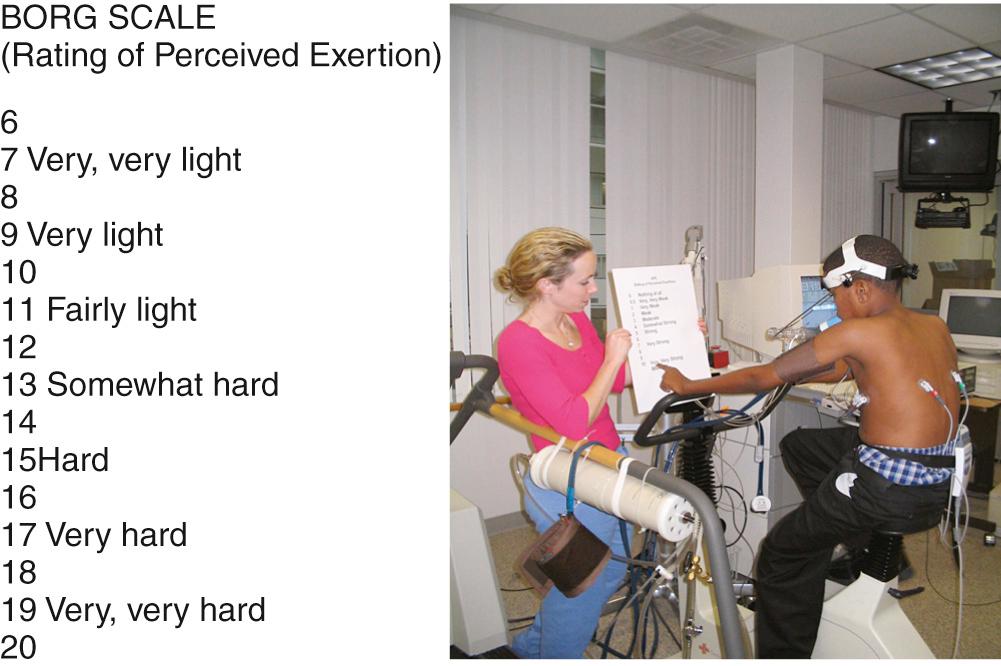
In most pediatric exercise laboratories, testing is primarily directed toward measuring aerobic capacity. Therefore ergometers should generate work in the large muscle groups. The two types of exercise testing equipment most commonly used are the motorized treadmill and the upright cycle ergometer. The choice of modality depends on the type of information desired, but there are both advantages and disadvantages to each modality ( Tables 23.1 and 23.2 ). It is therefore best that a laboratory be equipped to perform testing using either type of modality.
| Condition or Question | Cycle Ergometry | Treadmill | Rationale |
|---|---|---|---|
| Aortic stenosis/insufficiency | Preferred | ECG assessment for ischemia and blood pressure monitoring easier due to less motion artifact | |
| Repaired transposition of great arteries | Preferred | ECG assessment for ischemia or arrhythmia easier | |
| Repaired tetralogy of Fallot | Preferred | Arrhythmia assessment during exercise essential | |
| Coronary arterial obstruction (pre or post repair) | Preferred | Electrocardiographic assessment for ischemia | |
| Single ventricle/Fontan | Either | Either | Dependent upon clinical question |
| Coarctation of the aorta | Preferred | Blood pressure assessment more accurate | |
| Exercise-induced asthma/bronchospasm/chest pain | Preferred | Running more likely than cycling to induce symptoms | |
| Maximal aerobic fitness | Preferred | Higher V O 2 with treadmill compared to cycle | |
| Arrhythmia assessment/long QT | Preferred | Less motion artifact on ECG |
| Features | Treadmill | Cycle |
|---|---|---|
| Patient familiarity | + | |
| Higher work rates and oxygen consumption | + | |
| Greater pediatric experience | + | |
| Quantification of work performed | + | |
| Less ECG and blood pressure artifact | + | |
| Safety | + | |
| Expense | + | |
| Noise | + | |
| Compactness | + |
The advantage of the treadmill compared with the cycle ergometer is the familiarity that most children have with walking or running. Furthermore, more muscle groups are used with treadmill testing, resulting in a greater stress on the cardiovascular system and higher consumption of oxygen. Consumption of oxygen and the oxygen pulse are, on average, higher by 10% with treadmill testing compared with the cycle. Treadmill testing has been much more extensively studied for ischemia evaluation than has been cycle testing and, as a result, is much more commonly applied to adults referred for exercise testing. There is conflicting evidence on whether treadmill testing may be more sensitive for myocardial ischemia than cycle ergometry.
However, the treadmill also has several distinct disadvantages. It is noisy and may frighten small children. The increased movement from vigorous running results in much greater distortion of electrocardiographic and blood pressure signals compared with the cycle. The treadmill also requires more space and is not portable, and there is a danger of falling off the moving platform. Care must be taken to ensure that the patient is closely monitored and does not attempt to get off the treadmill abruptly. Another disadvantage of the treadmill is the inability to accurately determine rate of work (see Table 23.1 ). Although one can estimate work rate, the amount of work performed at a given stage of a treadmill protocol can vary widely based on patient weight and technique (e.g., walking vs. running; supporting weight with arms).
The Bruce protocol and its modifications are the most commonly used treadmill protocols in the pediatric exercise laboratory. This protocol consists of 3-minute stages, with an increase in both speed and grade of the treadmill at each stage. Despite its popularity, the incremental increases in work load for the Bruce protocol are large even when modified for children. This frequently makes the shift in rate of work between stages difficult for younger children. The relatively long stages also make for more difficultly in interpretation of metabolic data from analysis of expired gases. The graphic displays of various metabolic measurements, such as consumption of oxygen versus time, are not linear but rather appear as a series of slopes followed by partial plateaus. Such nonlinear graphic displays make determination of key parameters of exercise performance, such as the onset of the ventilatory anaerobic threshold, more challenging than in protocols with a continuous increase in work load.
In recent years, protocols with shorter stages, usually of 1 or 2 minutes, and smaller incremental increases in rates of work, have gained popularity. These protocols, such as the Balke treadmill protocol, may use a fixed speed, with increases only in grade, or may increase both speed and grade. These protocols can also be modified according to the age, size, and physical conditioning level of the child being tested, thereby allowing the total exercise time to be relatively constant for all subjects. Such a relatively constant duration of exercise is important because previous studies have demonstrated that total testing for more than approximately 12 to 15 minutes is associated with decreased aerobic performance, due to both shunting of blood to the skin for thermoregulation and poor motivation caused by boredom. A targeted total time of much less than 10 minutes may result in poor aerobic performance because the patient ceases exercising due to excessive muscle fatigue caused by the higher rates of work. The Bruce and Balke protocols are summarized in Fig. 23.9 .
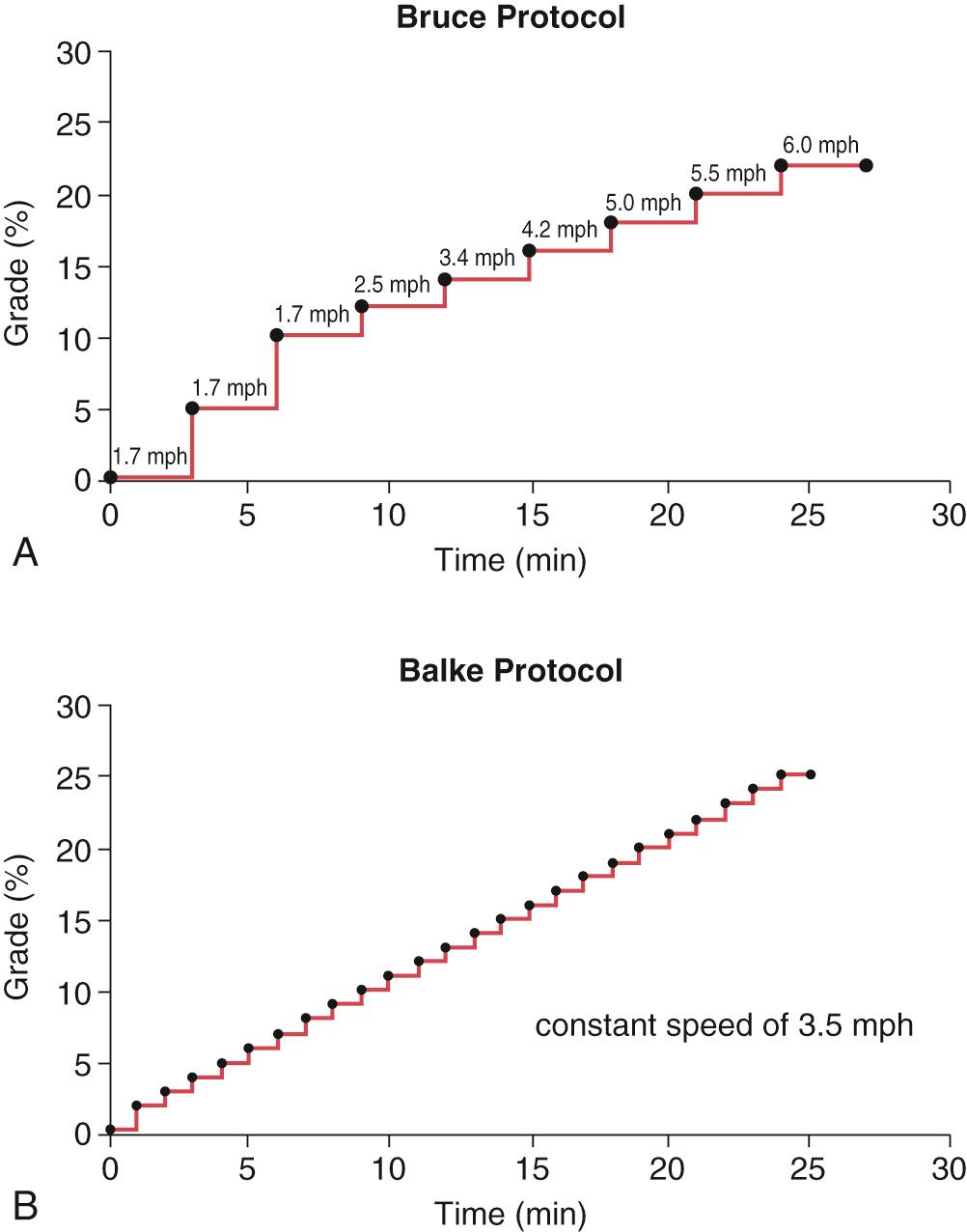
Cycle ergometers have several significant advantages compared with treadmills. A distinct advantage is decreased distortion of electrocardiographic and blood pressure recordings, particularly crucial when there are concerns about arrhythmias, ischemia, or changes in morphology of the QRS complexes. The cycle also accurately measures external work performed during the test. This requires that the rate of work be relatively independent of speed of pedaling. The ergometer should be regularly calibrated and carefully assessed before its use, in light of signal-to-noise ratio on some cycles, which may be excessive at the low initial rates of work used in pediatric protocols. Low signal-to-noise ratios are not common problems in the newer generation of cycles that use digital rather than analogue controllers of the rate of work. Other advantages of cycle ergometers include lower cost, portability, and increased safety. Musculoskeletal injuries are also less likely with a cycle.
Disadvantages, as stated previously, include a generally lower achieved level of maximal consumption of oxygen. In addition, many commercially available cycle ergometers are unable to accommodate children who are less than 130 cm in height because the crank arm is too large. Therefore ergometers used for testing children should have an adjustable crank arm. Several cycle ergometers are commercially available with pediatric modifications.
Historically, the most commonly used protocol was that devised by James, which consists of 10 stages, each lasting 3 minutes. The incremental increases for each stage vary depending upon body surface area. The James protocol has been extensively validated for use in children and hence has well-established normative data. Its major disadvantage is the difficulty of analyzing metabolic data with its long 3-minute stages, similar to those encountered with the Bruce protocol. Many now using “continuous” ramp cycle protocols have become the standard for pediatric research over the past decade and is currently commonly used in most exercise laboratories. In this protocol the rate of work is increased in small, frequently single-watt, increments, thus producing a smooth continuous rise throughout the test. These protocols have several advantages. First, the gradual rise in rate of work avoids problems encountered with the large sudden jumps seen when using 3-minute increments. Second, the slopes of the ramps are seamlessly adjusted to accommodate a wide range of sizes, ages, and levels of physical conditioning. Third, relationships between metabolic data and rate of work are easier to appreciate with this type of protocol, facilitating the analysis of collected gases. The James and continuous ramp protocols are depicted in Fig. 23.10 .
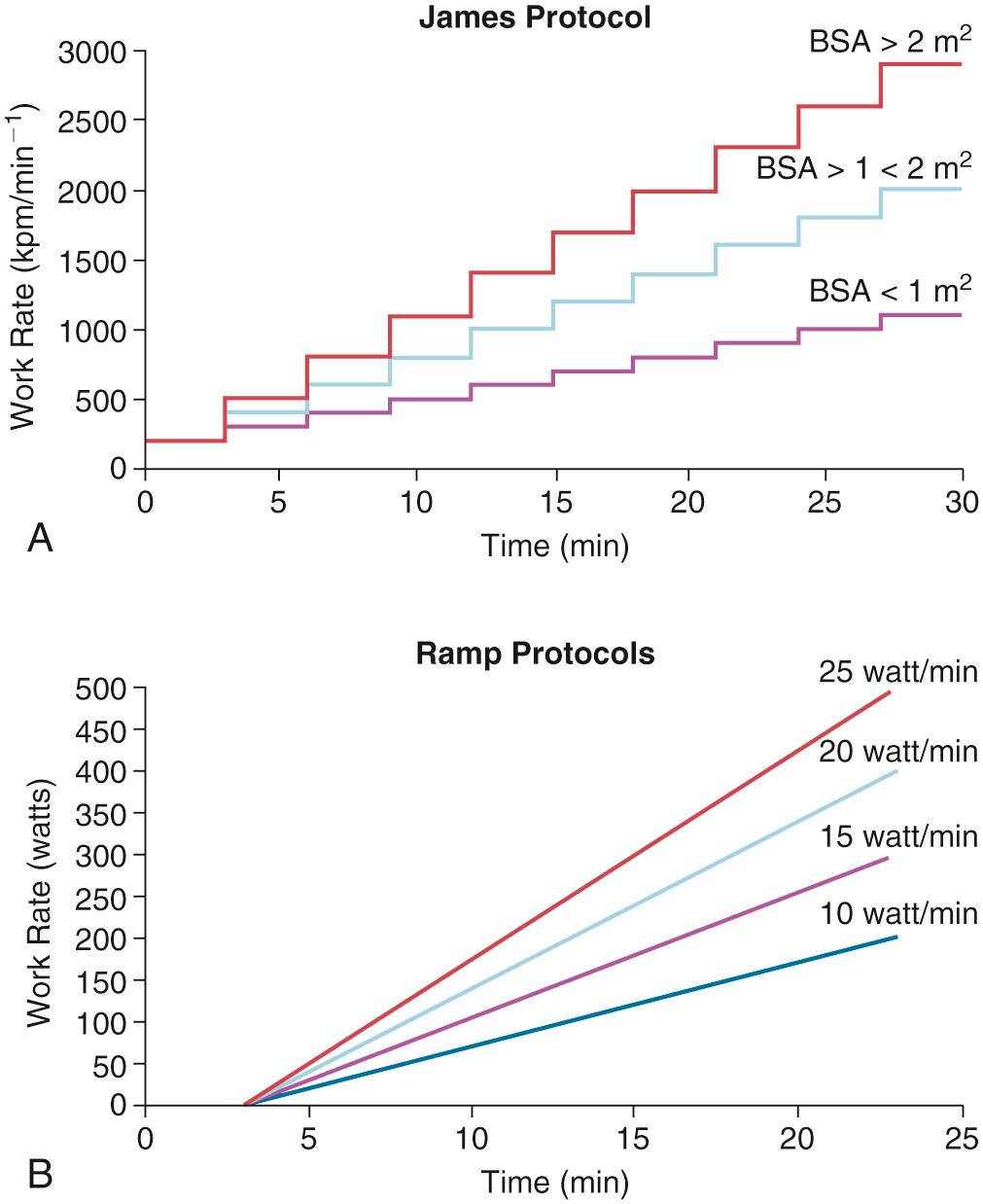
Many high-quality commercial electrocardiographic recording systems are available. No system currently available is designed specifically for pediatric use, but all are generally acceptable without modification. Minimization of distortion of signals is accomplished with computer digitization of the analogue electrical signal.
A standard real-time display is essential so that the rhythm, and morphology of the QRS complexes, can be monitored continuously. The display should show at least one, and ideally multiple, leads continuously. The technician obtains a complete 12-lead recording at set time intervals, usually of 1 minute, and when needed during the course of an exercise test. Ideally, all QRS complexes should be stored, either as a hard copy or digitally. Automated devices are available on many recorders to detect arrhythmias and are useful but may be limited when abnormal QRS complexes, pacemaker-generated complexes, or significant motion artifact are present.
Most computerized recorders have algorithms that will average the recorded signals, thus eliminating baseline drift and background artifact, permitting easy interpretation of changes in the QRS and ST segments. It is possible that data may be lost with certain algorithms at very high heart rates, so it is important to compare the averaged with the raw data when interpreting the test.
The use of these analyzers has become routine in laboratories studying pediatric exercise physiology. Measurements of consumption of oxygen, production of carbon dioxide, and pulmonary functions, such as minute ventilation, tidal volume, and respiratory rate, are easily obtainable. Several systems at reasonable prices are commercially available. In addition to measuring expired gases, these systems are frequently equipped to perform resting spirometry and to receive input from other sources, such as an electrocardiographic recorder. This allows a single system to generate complete and final reports.
Analyzers using inert gases can be used to estimate cardiac output. The patient breathes room air during most of the test. During the measurements of cardiac output, ventilation is diverted via a valve into a closed system, usually through a 3-L rebreathing bag, containing a mixture of oxygen, an inert diffusible gas, and an inert nondiffusible gas. After one to three breaths, the nondiffusible gas equilibrates between the lungs and the bag, and the final concentration of this gas can be used to calculate the volume of the lungs. The diffusible gas is removed from the system in proportion to the flow of blood to the lungs. The assumption when assessing cardiac output is that flows are equal in the pulmonary and systemic circulations, and there is no significant intrapulmonary or intracardiac shunting. The calculated flow of blood to the lungs then reliably estimates systemic cardiac output. Unfortunately, residual pulmonary and/or intracardiac shunts frequently limit the usefulness of this measurement. Such assessment also requires patient cooperation and tester expertise in performing the rebreathing maneuvers correctly.
Acetylene and helium are commonly used inert soluble and insoluble gases, respectively. A mass spectrometer or similar device is usually required ( Fig. 23.11 ). Compact, commercially available systems are currently available but may have difficulty interfacing with other metabolic carts and measurement devices. One such system uses nitrous oxide and sulfur hexafluoride. Such commercial systems are less costly and more user friendly than individually designed systems. This approach has been validated in children and adult with congenital heart disease who do not have a left-to-right shunt and even in mechanically ventilated children. Alternatively, rebreathing of carbon dioxide can be used in some commercially available systems. The latter system uses the indirect Fick method to estimate cardiac output. A number of assumptions are necessary to estimate arterial partial pressures of carbon dioxide, which may result in significant inaccuracies, especially in patients with congenital cardiac disease. The rebreathing method also has the disadvantage of requiring steady state minute ventilation and therefore is not suitable for protocols with frequently changing work rate.
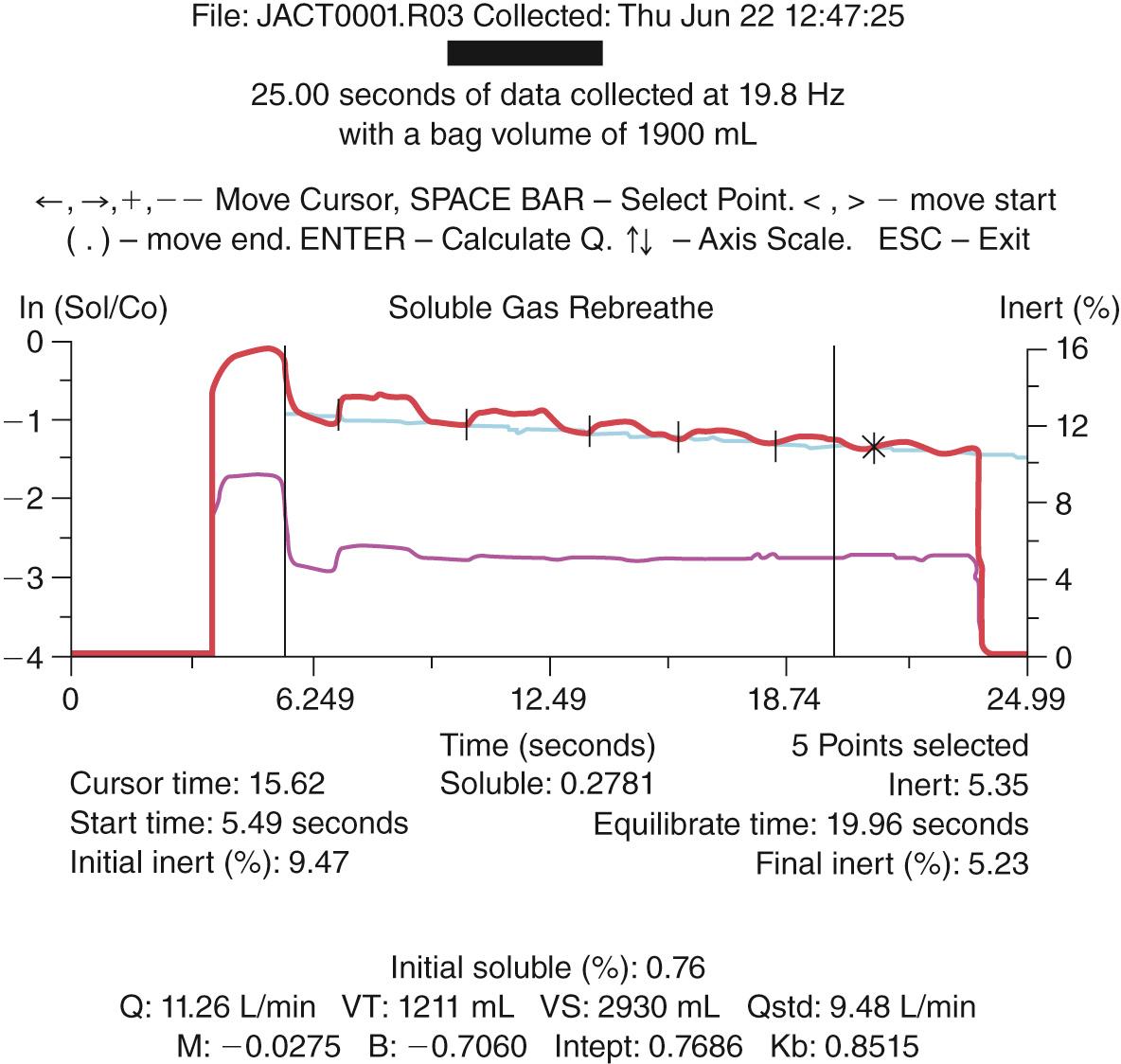
Methods for noninvasive measurement used less frequently with exercise testing include electrical bioimpedance and Doppler measurement of aortic blood flow. Bioimpedance requires very little cooperation from the patient, but studies comparing this method with diffusible gas and other methods have shown poor correlation. These devices are subject to motion artifact, which makes measurement during actual exercise limited. Measurements at rest and immediately after peak exercise, such as with a 6-minute walk test, may be the most useful for these types of devices. Correlations of Doppler with diffusible gas and other methods are also suboptimal, and obtaining an adequate Doppler signal with exercise remains a cumbersome undertaking.
Essential measurements include basic inspiratory and expiratory flow volume loops and assessment of maximal voluntary ventilation. Maximal voluntary ventilation is measured by the sprint method as outlined by the American Thoracic Society, wherein maximal ventilation is measured for an interval of 10 to 15 seconds and extrapolated to 1 minute. Spirometry is used to identify patterns of obstructive or restrictive pulmonary disease that could impair exercise performance. Postexercise spirometry is useful for identifying patients with exercise-induced bronchospasm. Maximal voluntary ventilation is used in the assessment of the remaining pulmonary capacity at the end of exercise, the breathing reserve. As already discussed, this is the fraction of the capacity of the pulmonary system to increase minute ventilation that remains at maximal exercise, with normal values ranging from 20% to 50%. In situations of testing where the maximal voluntary ventilation sprint method is not feasible, it may be estimated using any one of the following equations:
where MVV is maximal voluntary ventilation, and FEV 1 is forced expiratory volume in 1 second.
Although widely accepted as accurate in healthy adults, not all the previous equations have been validated in healthy children, albeit the first equation has been validated in healthy African-American adolescent girls. Therefore, whenever possible, maximal voluntary ventilation should be determined using the sprint method as recommended by the American Thoracic Society.
Monitoring of blood pressure can be a significant problem during exercise testing due to artifact from motion of the arm, making accurate measurements difficult to obtain. This is a greater problem with treadmill than with cycle ergometry. Automated systems designed for exercise testing incorporating a sensitive microphone positioned over the brachial artery are currently commonly used in many laboratories. Many of these systems simultaneously receive an electrocardiographic signal, allowing precise gating to the QRS complex while filtering background noise. These systems generally measure pressure both oscillometrically and, using headphones, by direct auscultation. Direct auscultation is the preferred method because there is a tendency to overestimate systolic and underestimate diastolic pressures with oscillometric measurements. Several sizes of blood pressure cuffs are necessary equipment. Most automated systems also have pediatric-sized cuffs, as well as oversized cuffs for large subjects.
Pulse oximeters fitted for the finger or ear are used to measure arterial oxygen saturation. The devices can be inaccurate, particularly at high rates of work, when children are prone to grasp the cycle handlebars too tightly. Therefore ear oximetry is better for laboratories using primarily cycle ergometry. All oximeters are less accurate at higher rates of work, due to excessive motion.
Become a Clinical Tree membership for Full access and enjoy Unlimited articles
If you are a member. Log in here